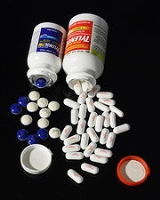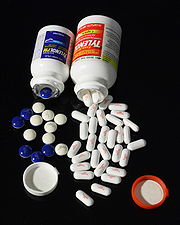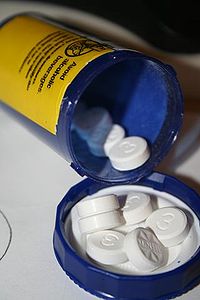
Tylenol
Encyclopedia



North American
North American generally refers to an entity, people, group, or attribute of North America, especially of the United States and Canada together.-Culture:*North American English, a collective term used to describe American English and Canadian English...
brand
Brand
The American Marketing Association defines a brand as a "Name, term, design, symbol, or any other feature that identifies one seller's good or service as distinct from those of other sellers."...
of drug
Drug
A drug, broadly speaking, is any substance that, when absorbed into the body of a living organism, alters normal bodily function. There is no single, precise definition, as there are different meanings in drug control law, government regulations, medicine, and colloquial usage.In pharmacology, a...
s advertised for reducing pain
Analgesic
An analgesic is any member of the group of drugs used to relieve pain . The word analgesic derives from Greek an- and algos ....
, reducing fever
Fever
Fever is a common medical sign characterized by an elevation of temperature above the normal range of due to an increase in the body temperature regulatory set-point. This increase in set-point triggers increased muscle tone and shivering.As a person's temperature increases, there is, in...
, and relieving the symptoms of allergies
Allergy
An Allergy is a hypersensitivity disorder of the immune system. Allergic reactions occur when a person's immune system reacts to normally harmless substances in the environment. A substance that causes a reaction is called an allergen. These reactions are acquired, predictable, and rapid...
, cold
Common cold
The common cold is a viral infectious disease of the upper respiratory system, caused primarily by rhinoviruses and coronaviruses. Common symptoms include a cough, sore throat, runny nose, and fever...
, cough
Cough
A cough is a sudden and often repetitively occurring reflex which helps to clear the large breathing passages from secretions, irritants, foreign particles and microbes...
, and flu. The active ingredient of its original, flagship product, paracetamol
Paracetamol
Paracetamol INN , or acetaminophen USAN , is a widely used over-the-counter analgesic and antipyretic . It is commonly used for the relief of headaches and other minor aches and pains and is a major ingredient in numerous cold and flu remedies...
(called acetaminophen in North America), is marketed as an analgesic
Analgesic
An analgesic is any member of the group of drugs used to relieve pain . The word analgesic derives from Greek an- and algos ....
and antipyretic
Antipyretic
Antipyretics ; an-tee-pahy-ret-iks; from the Greek anti, against, and pyreticus, are drugs or herbs that reduce fever. Normally, they will not lower body temperature if one does not have a fever. Antipyretics cause the hypothalamus to override an interleukin-induced increase in temperature...
. Like the words "acetaminophen" and "paracetamol", the brand name is derived from the chemical name for the compound, N-acetyl-para-aminophenol (APAP). The brand is owned by McNeil Consumer Healthcare
McNeil Laboratories
McNeil Consumer Healthcare is a medicals products company belonging to the Johnson & Johnson healthcare products group.-History:The company was founded on March 16, 1879 by 23-year-old Robert McNeil, who paid $167 for a drugstore complete with fixtures, inventory and soda fountain, as a retail...
, a subsidiary of Johnson & Johnson
Johnson & Johnson
Johnson & Johnson is an American multinational pharmaceutical, medical devices and consumer packaged goods manufacturer founded in 1886. Its common stock is a component of the Dow Jones Industrial Average and the company is listed among the Fortune 500....
.
History
James Roth, a U.S. gastroenterologistGastroenterology
Gastroenterology is the branch of medicine whereby the digestive system and its disorders are studied. The name is a combination of three Ancient Greek words gaster , enteron , and logos...
, advocated paracetamol
Paracetamol
Paracetamol INN , or acetaminophen USAN , is a widely used over-the-counter analgesic and antipyretic . It is commonly used for the relief of headaches and other minor aches and pains and is a major ingredient in numerous cold and flu remedies...
as a gastric-friendly alternative to aspirin
Aspirin
Aspirin , also known as acetylsalicylic acid , is a salicylate drug, often used as an analgesic to relieve minor aches and pains, as an antipyretic to reduce fever, and as an anti-inflammatory medication. It was discovered by Arthur Eichengrun, a chemist with the German company Bayer...
, which can irritate the stomach when taken without food. Roth was also principal consultant to McNeil Laboratories
McNeil Laboratories
McNeil Consumer Healthcare is a medicals products company belonging to the Johnson & Johnson healthcare products group.-History:The company was founded on March 16, 1879 by 23-year-old Robert McNeil, who paid $167 for a drugstore complete with fixtures, inventory and soda fountain, as a retail...
. In 1953, McNeil Laboratories introduced Algoson, a preparation containing paracetamol together with sodium butabarbital
Butabarbital
Butabarbital is a prescription barbiturate sleep aid. Butabarbital has a particularly fast onset of effects and short duration of action compared to other barbiturates, which makes it useful for certain applications such as treating severe insomnia and relieving anxiety before surgical procedures;...
, a sedative. In 1955, McNeil Laboratories introduced Tylenol Elixir for children, which contained paracetamol as its sole active ingredient. It was originally marketed mainly towards children, but soon came to dominate the North American pain-killer market. There are a number of different varieties of Tylenol available today including extra-strength (with 500 milligrams of paracetamol), children's doses, longer-lasting, and sleep aiding (in combination with diphenhydramine
Diphenhydramine
Diphenhydramine hydrochloride is a first-generation antihistamine possessing anticholinergic, antitussive, antiemetic, and sedative properties which is mainly used to treat allergies. Like most other first-generation antihistamines, the drug also has a powerful hypnotic effect, and for this reason...
). In 2005, Tylenol Ultra was introduced in Canada, with 500 mg of paracetamol and 65 mg of caffeine
Caffeine
Caffeine is a bitter, white crystalline xanthine alkaloid that acts as a stimulant drug. Caffeine is found in varying quantities in the seeds, leaves, and fruit of some plants, where it acts as a natural pesticide that paralyzes and kills certain insects feeding on the plants...
; caffeine has vasoconstricting
Vasoconstriction
Vasoconstriction is the narrowing of the blood vessels resulting from contraction of the muscular wall of the vessels, particularly the large arteries, small arterioles and veins. The process is the opposite of vasodilation, the widening of blood vessels. The process is particularly important in...
effects, for which there is some disputed evidence for additional effectiveness. The patent on paracetamol has long expired, and the continued success of Tylenol brand preparations are largely due to marketing, the backing and reputation of Johnson & Johnson, and new patented delivery mechanisms such as quick-release and extended-release forms of the medication.
1982 Chicago Tylenol murders and first recall
On September 29, 1982, a "Tylenol scare" began when the first of seven individuals died in metropolitan Chicago, after ingesting Extra Strength Tylenol that had been deliberately contaminated with cyanideCyanide
A cyanide is a chemical compound that contains the cyano group, -C≡N, which consists of a carbon atom triple-bonded to a nitrogen atom. Cyanides most commonly refer to salts of the anion CN−. Most cyanides are highly toxic....
. Within a week, the company pulled 31 million bottles of tablets back from retailers, making it one of the first major recalls in American history.
As a result of the crisis, all Tylenol capsules were discontinued, as were capsules of other brand names. Tamper-proof, triple-sealed safety containers were swiftly placed on the shelves of retailers 10 weeks after the withdrawal. Other manufacturers followed suit. The crisis cost the company more than $100 million. Tylenol regained 100% of the market share it had before the crisis. Seven people died. The Tylenol murderer was never found. A $100,000 reward offered by Johnson & Johnson still remains unclaimed.
Tylenol remains a top seller, controlling about 35% of the pain killer market in North America.
2010 Tylenol recall
On January 15, 2010, 20 months after first receiving consumer complaints, Johnson & Johnson announced a voluntary recall of several hundred batches of popular medicines, including Benadryl, Motrin, Rolaids, Simply Sleep, St. Joseph Aspirin and Tylenol. The recall was due to complaints of a musty smell which is suspected to be due to contamination of the packaging with the chemical 2,4,6-tribromoanisole2,4,6-Tribromoanisole
2,4,6-Tribromoanisole is a chemical compound that is a brominated derivative of anisole. It is one of the chemicals responsible for cork taint....
. The full health effects of 2,4,6-tribromoanisole are not known but no serious events have been documented in the medical literature. The recall came 20 months after McNeil first began investigating consumer complaints about moldy-smelling bottles of Tylenol Arthritis Relief caplets, according to the United States Food and Drug Administration.
The recall included 53 million bottles of over-the-counter products including Tylenol, Motrin and Rolaids, Benadryl and St. Joseph's Aspirin, involving lots in the Americas, the United Arab Emirates and Fiji
Fiji
Fiji , officially the Republic of Fiji , is an island nation in Melanesia in the South Pacific Ocean about northeast of New Zealand's North Island...
.
On April 30, 2010, another recall
2010 Johnson & Johnson children's product recall
The 2010 Johnson & Johnson children's product recall was a voluntary recall of 43 over-the-counter children's medicines announced by McNeil Consumer Healthcare, a subsidiary of Johnson & Johnson, on April 30, 2010. Medications in the recall included liquid versions of Tylenol, Tylenol Plus, Motrin,...
was issued for 40 products including liquid infant and children's pain relievers, Tylenol, and Motrin and allergy medications Zyrtec and Benadryl
Benadryl
Benadryl is a brand name allergy medicine marketed over-the-counter by Johnson & Johnson subsidiary McNeil Consumer Healthcare. Prior to 2007, Benadryl was marketed by Pfizer Consumer Healthcare...
. A Food and Drug Administration
Food and Drug Administration
The Food and Drug Administration is an agency of the United States Department of Health and Human Services, one of the United States federal executive departments...
report said its inspectors found thick dust and grime covering certain equipment, a hole in the ceiling and duct tape-covered pipes at the Fort Washington, Pennsylvania
Fort Washington, Pennsylvania
Fort Washington is an unincorporated census-designated place and suburb of Philadelphia in Montgomery County, Pennsylvania, United States. The population was 5,446 at the 2010 census.-Prior to the Revolutionary War:...
, facility that made 40 products recalled.
On Wednesday, May 5, 2010, the Food and Drug Administration
Food and Drug Administration
The Food and Drug Administration is an agency of the United States Department of Health and Human Services, one of the United States federal executive departments...
(FDA) confirmed that the bacteria found at the Johnson & Johnson plant that made the recalled Children's Tylenol was Burkholderia cepacia, a bacteria often resistant to common antibiotics. The CDC has stated that Burkholderia cepacia is not likely to cause health problems for those with healthy immune systems but those with weaker ones and those with chronic lung diseases, such as cystic fibrosis, could be more susceptible to infection.
Dangers
Acetaminophen causes three times as many cases of liver failure as all other drugs combined,and is the most common cause of acute liver failure in the United States,
accounting for 39% of cases. While this generally occurs through overdosing, the window of toxicity can increase at lower than toxic doses when acetaminophen is combined with alcohol, especially in heavier drinkers, or those with compromised liver function as a result of alcohol use.
Acetaminophen is metabolized in the liver, resulting in a by-product, N-acetyl-p-benzoquinone imine (NAPQI), that can damage liver cells, but is typically converted into a harmless substance by an antioxidant glutathione. However, large doses of acetaminophen overwhelms the body's supply of glutathione, resulting in destruction of the liver cells.
People who have the highest risk for Acetaminophen related kidney failure include: heavy drinkers (three or more drinks per day), elderly men, and persons with pre-existing liver or kidney damage.
A study published by the Journal of the American Medical Association in 2006 suggests problems even in healthy people taking the pain reliever as directed. Healthy adults taking maximum doses of Tylenol for two weeks had abnormal liver test results. Dr. Neil Kaplowitz of the University of Southern California, co-author of the study, said,
"I would urge the public not to exceed four grams a day. This is a drug that has a rather narrow safety window..."
According to a preliminary study mixing acetaminophen and caffeine may cause liver damage, especially in heavy caffeine drinkers. Researchers discovered that caffeine can triple the amount of, N-acetyl-p-benzoquinone imine (NAPQI), the dangerous by product which destroys liver cells. This reaction can also be caused by large doses of painkillers that combine caffeine and acetaminophen (e.g., Anacin, Excedrin & Midol). These products are often used to treat migraines and menstrual discomfort. Dr. Sid Nelson, a professor of medicinal chemistry at the University of Washington said, "Caffeine can interact with an enzyme that can form a toxic metabolite of acetaminophen in such a way that it increases the formation of that toxic metabolite".
Symptoms from an overdose of acetaminophen typically appear after 24 hours, or in some cases up to 48 hours, however immediate treatment prior to the onset of symptoms can greatly improve the outcome. The antidote to acetaminophen overdose, N-acetylcysteine (NAC), is most effective when taken within eight-hours of an overdose. Due to the delayed symptoms and the importance of immediate treatment, overdoses of acetaminophen kill about 12% of those who seek treatment. Typical symptoms range from nausea and malaise to extreme upper abdominal pain in the region of the liver.
Tylenol is only one among many popular medications containing acetaminophen, but few users realize that it is contained in hundreds of other pain relievers and cold remedies, and that combined usage has a cumulative effect. Fifteen percent of accidental overdoses involve the simultaneous use of more than one product containing acetaminophen. Products from common brands include acetaminophen: Excedrin, Midol, Theraflu, Alka-Seltzer and NyQuil, as well as prescription narcotics such as Vicodin and Percocet. Following the recommended dosages for each, but in combination can far exceed safe limits for acetaminophen intake. The manufacturers of Tylenol recommend, "You should not take two or more products that contain acetaminophen at the same time."
The effectiveness of acetaminophen (paracetamol) alone as an antipyretic
Antipyretic
Antipyretics ; an-tee-pahy-ret-iks; from the Greek anti, against, and pyreticus, are drugs or herbs that reduce fever. Normally, they will not lower body temperature if one does not have a fever. Antipyretics cause the hypothalamus to override an interleukin-induced increase in temperature...
(fever
Fever
Fever is a common medical sign characterized by an elevation of temperature above the normal range of due to an increase in the body temperature regulatory set-point. This increase in set-point triggers increased muscle tone and shivering.As a person's temperature increases, there is, in...
-reducing drug) in children is uncertain with some evidence showing it is no better than physical methods. Therapies involving the combination of acetaminophen and aspirin
Aspirin
Aspirin , also known as acetylsalicylic acid , is a salicylate drug, often used as an analgesic to relieve minor aches and pains, as an antipyretic to reduce fever, and as an anti-inflammatory medication. It was discovered by Arthur Eichengrun, a chemist with the German company Bayer...
, or alternating doses of acetaminophen and ibuprofen
Ibuprofen
Ibuprofen is a nonsteroidal anti-inflammatory drug used for relief of symptoms of arthritis, fever, as an analgesic , especially where there is an inflammatory component, and dysmenorrhea....
have shown somewhat greater antipyretic effect than acetaminophen alone.
Link with Childhood Asthma
Dr. John McBride reported in the journal, Pediatrics, http://pediatrics.aappublications.org/content/early/2011/11/04/peds.2011-1106.full.pdf+html?sid=292aac87-0b02-4f3f-86c7-99a0bccb2314 on 1st November 2011, that Acetaminophen, marketed as Tylenol in the USA and in the UK as Paracetamol, may worsen asthma symptoms in both adults and children. He reviewed recent studies on the medication, which suggest that the drug may exacerbate asthma in children and adults who already have the condition and could even spark new cases.
One of studies McBride cites looked at 520,000 children from 122 centers in 54 countries. In a report on that data published in The Lancet in 2008, researchers found that the risk of developing asthma jumped by 60 percent in 6- to 7-year-olds who had taken acetaminophen at least once a year but less than once a month. In children who took the medication at least once a month, the risk more than tripled.
A second report using the same data was published in the American Journal of Respiratory and Critial Care Medicine in 2011. That report found that the risk of developing asthma jumped by 40 percent in 13- to 14-year olds who had taken acetaminophen at least once a year but less than once a month. In children of the same age group who took the medication at least once a month, the risk more than doubled. Other studies found acetaminophen associated with an increased risk of asthma in adults.
Products

Allergy
An Allergy is a hypersensitivity disorder of the immune system. Allergic reactions occur when a person's immune system reacts to normally harmless substances in the environment. A substance that causes a reaction is called an allergen. These reactions are acquired, predictable, and rapid...
, and cold
Common cold
The common cold is a viral infectious disease of the upper respiratory system, caused primarily by rhinoviruses and coronaviruses. Common symptoms include a cough, sore throat, runny nose, and fever...
- and flu- related symptoms. Allergy and cold products also contain dextromethorphan
Dextromethorphan
Dextromethorphan is an antitussive drug. It is one of the active ingredients in many over-the-counter cold and cough medicines, such as Robitussin, NyQuil, Dimetapp, Vicks, Coricidin, Delsym, and others, including generic labels. Dextromethorphan has also found other uses in medicine, ranging...
, antihistamine
Antihistamine
An H1 antagonist is a histamine antagonist of the H1 receptor that serves to reduce or eliminate effects mediated by histamine, an endogenous chemical mediator released during allergic reactions...
s, and expectorants.
Tylenol is also sold as a class of stronger pain relievers containing codeine
Codeine
Codeine or 3-methylmorphine is an opiate used for its analgesic, antitussive, and antidiarrheal properties...
, known as co-codamol
Co-codamol
Co-codamol is a non-proprietary name used to denote a compound analgesic, a combination of codeine phosphate and paracetamol . Co-codamol Co-codamol (BAN) is a non-proprietary name used to denote a compound analgesic, a combination of codeine phosphate and paracetamol (acetaminophen). Co-codamol...
s: Tylenol 1 contains 325 mg acetaminophen and 8 mg codeine; Tylenol 2 contains 300 mg/15 mg, Tylenol 3 (300 mg/30 mg), and Tylenol 4 (300 mg/60 mg). In Canada, Tylenol 1, 2 and 3 all include 15 mg caffeine, in addition to the above ingredients; furthermore, Tylenol 1 is sold in Canada without a prescription, while all forms of Tylenol with codeine require a prescription in the US.
Acetaminophen is also found in other narcotic-based analgesic
Analgesic
An analgesic is any member of the group of drugs used to relieve pain . The word analgesic derives from Greek an- and algos ....
s such as Percocet
Percocet
The combination oxycodone/paracetamol is a narcotic pain reliever used to treat moderate to severe acute pain, marketed by Endo Pharmaceuticals.-History:The U.S...
which additionally contains oxycodone
Oxycodone
Oxycodone is an opioid analgesic medication synthesized from opium-derived thebaine. It was developed in 1916 in Germany, as one of several new semi-synthetic opioids in an attempt to improve on the existing opioids: morphine, diacetylmorphine , and codeine.Oxycodone oral medications are generally...
, and Lortab/Vicodin
Vicodin
Hydrocodone/paracetamol is a combination of two analgesic products hydrocodone and paracetamol used to relieve moderate to severe pain...
which both additionally contain hydrocodone
Hydrocodone
Hydrocodone or dihydrocodeinone is a semi-synthetic opioid derived from either of two naturally occurring opiates: codeine and thebaine. It is an orally active narcotic analgesic and antitussive...
.
Tylenol PM
Tylenol PM is the trademarkTrademark
A trademark, trade mark, or trade-mark is a distinctive sign or indicator used by an individual, business organization, or other legal entity to identify that the products or services to consumers with which the trademark appears originate from a unique source, and to distinguish its products or...
for a mixture of acetaminophen (paracetamol) and diphenhydramine
Diphenhydramine
Diphenhydramine hydrochloride is a first-generation antihistamine possessing anticholinergic, antitussive, antiemetic, and sedative properties which is mainly used to treat allergies. Like most other first-generation antihistamines, the drug also has a powerful hypnotic effect, and for this reason...
, distributed by Johnson & Johnson
Johnson & Johnson
Johnson & Johnson is an American multinational pharmaceutical, medical devices and consumer packaged goods manufacturer founded in 1886. Its common stock is a component of the Dow Jones Industrial Average and the company is listed among the Fortune 500....
. It is marketed as a combined analgesic
Analgesic
An analgesic is any member of the group of drugs used to relieve pain . The word analgesic derives from Greek an- and algos ....
and sedative
Sedative
A sedative or tranquilizer is a substance that induces sedation by reducing irritability or excitement....
. It is listed as non-habit forming. Diphenhydramine is an anticholinergic
Anticholinergic
An anticholinergic agent is a substance that blocks the neurotransmitter acetylcholine in the central and the peripheral nervous system. An example of an anticholinergic is dicycloverine, and the classic example is atropine....
used as the active ingredient in Benadryl
Benadryl
Benadryl is a brand name allergy medicine marketed over-the-counter by Johnson & Johnson subsidiary McNeil Consumer Healthcare. Prior to 2007, Benadryl was marketed by Pfizer Consumer Healthcare...
, for its antihistamine
Antihistamine
An H1 antagonist is a histamine antagonist of the H1 receptor that serves to reduce or eliminate effects mediated by histamine, an endogenous chemical mediator released during allergic reactions...
properties, and Benylin
Benylin
Benylin is a brand name owned by Johnson & Johnson for a range of cough, cold and flu medications. The flagship cough syrup and cold care brand is marketed in several countries as Benylin DM, for its active ingredient, dextromethorphan...
, which is used in cough and cold therapy as an antitussive (anti-cough) medication. As its name implies, the product is a sleep aid medication.
Advertisements
Tylenol has many different advertisement approaches. One of these advertisement campaigns focuses on “getting you back to normal”, whereas the other commercials focus on Tylenol’s current slogan, “Feel better, Tylenol”. In the “Feel better, Tylenol” commercials, Tylenol places emphasis on the importance of sleep; various people are seen sleeping in this commercial while a voiceover describes how sleep can help repair and heal the human body during times of aches and pains. In the “getting you back to normal” commercial, Tylenol places more emphasis on helping its consumers get back to their daily routines; many different people are shown first experiencing headaches and other sorts of body pain, where a voiceover then states that Tylenol Rapid Release can help rid aches and pains; the various people are then showed enjoying their everyday lives, and are seen as “back to normal”.In an older commercial from 1986, Tylenol emphasized that it is the drug that American hospitals trust the most. In this ad, Susan Sullivan
Susan Sullivan
Susan Michaela Sullivan is an American actress, known for several notable roles on various television programs. Sullivan played the role of Lenore Curtin Delaney on the daytime soap opera, Another World ; waitress Lois Adams during the first season of the comedy It's a Living, Maggie Gioberti...
told the consumer that Tylenol was a drug that could be trusted by Americans since many doctors also trusted it; she went on to state that doctors prescribed Tylenol four times more often than the other leading pain relieving drugs combined.

